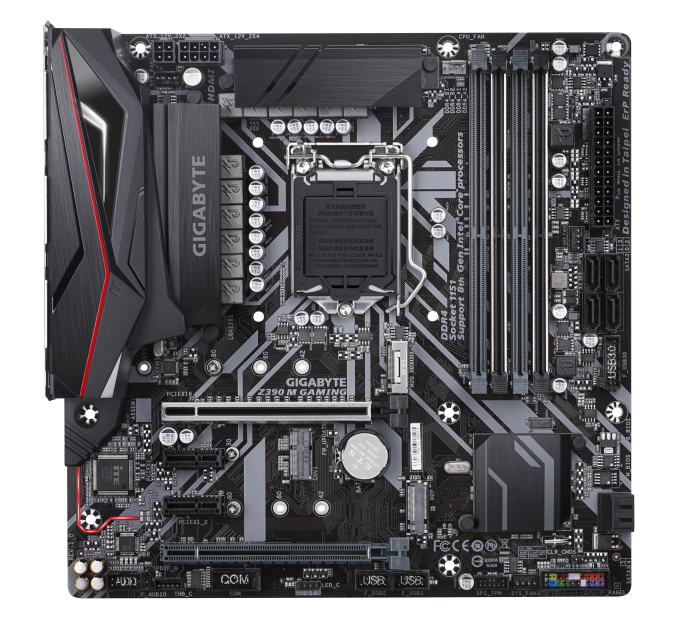Intel Z390 Motherboard Overview: 50+ Motherboards Analyzed
by Ian Cutress & Gavin Bonshor on October 8, 2018 10:53 AM EST- Posted in
- Motherboards
- Intel
- MSI
- Gigabyte
- ASRock
- EVGA
- Asus
- NZXT
- Supermicro
- Z390
GIGABYTE Z390M Gaming
The Z390M Gaming as it stands is the only mATX motherboard from GIGABYTE at the launch of the Intel 9th generation processors and shares a similar design to the Z390 Gaming SLI and Z390 Gaming X with a grey and black color scheme which has a red accent on the power delivery heatsink. Like the other pair just mentioned, the Z390M Gaming has dual CPU 12 V ATX power inputs (8 and 4-pin) and looks to have a 12-phase set up like the ATX sized gaming boards. Memory support is much the same too as the Z390M Gaming has four available RAM slots with a support for up to and including 64 GB with a published list of supported memory speeds currently unknown.
In terms of PCIe slots, the Z390M Gaming has two full-length PCIe 3.0 slots which operate at x16 and 4x respectively, with the top slot featuring metal slot reinforcement. The board also includes two PCIe 3.0 x1 slots and the board itself supports up to two-way CrossFire multi-graphics card configurations; virtually the same as the bigger ATX sized Z390 Gaming X. Similar to the aforementioned bigger sibling, the Z390M Gaming has six SATA ports with two right-angled ports and four straight-angled connectors located just below the 24-pin 12V motherboard power input. The board offers two M.2 slots which have support for both PCIe 3.0 x4 and SATA based drives.
On the rear panel, the mATX Z390M Gaming includes two USB 3.1 Gen2 (Type-A and Type-C) and four USB 3.0 Type-A ports. The board has two video outputs which consist of a DVI-D and HDMI port, and also includes a PS/2 combination keyboard and mouse port. A single LAN port is also present which is powered by an Intel I219V Gigabit controller and the six 3.5 mm audio jacks take their direction from a Realtek ALC892 HD audio codec.
The Z390M Gaming looks set to retail for $145 which is a similar price as the Z390 Gaming X ($150), which seems to be its shorter twin sibling and looks to give users looking to build a mATX gaming system an option to consider. Those looking to run two-way SLI on the smaller mATX form factor though will have to look elsewhere due to bandwidth constraints (x4) on the second full-length PCIe 3.0 slot.












79 Comments
View All Comments
Smell This - Tuesday, October 9, 2018 - link
Much.Of.
The.
Same.
2 HSIO lanes per Gen 2 port and WiFi. Wow (rolling I-eyeballs) ...
MadAd - Tuesday, October 9, 2018 - link
58 motherboards, only 13 of which are smaller than ATX. When on earth are we going to move off this outdated oversized format? Its just more of the same every time, so depressing.gavbon - Wednesday, October 10, 2018 - link
13 is better than 0, or 12 :DMadAd - Wednesday, October 10, 2018 - link
Considering very small form formats (ITX) are harder to build for and only 7 are uATX, a size which is the most useful to transition away from ATX then no, it feels like an afterthought from a lazy industry. I mean who uses more than 1 main video card and 2-4 sticks of ram in a gaming PC these days? Even water builds into uATX isnt that hard to accomplish.After literally decades ATX should be a choice for edge cases not a mainstream build.
shaolin95 - Monday, October 22, 2018 - link
who cares about midge boards!Edkiefer - Wednesday, October 10, 2018 - link
All these MB with 2x 8 pin power inputs, is both mandatory and if so I guess new PSU will need 2x 8pin now.entity279 - Wednesday, October 10, 2018 - link
so it's ok to just buy SM motherboards now with them being involved in a security scandal?gavbon - Thursday, October 11, 2018 - link
I currently have the Supermicro C9Z390-PGW awaiting to go on the test bench next week, so from a consumers standpoint, I could potentially shed light on that board. As far as the Chinese/Supermicro/Spy scandal goes, I don't want to speculate without the finer details.eastcoast_pete - Wednesday, October 10, 2018 - link
Ian & Gavin, thanks for the overview.@ both - Question: I've read that Intel, to deal with its bad planning/capacity problems on 14 nm, has contracted the fabbing of some of its chipsets out to TSMC, specifically in TSMC's 22 nm tech. Is that correct, and did you have a chance to confirm that the new 390s used by these boards are indeed made by Intel on their 14 nm FinFET tech, or are they made by a contractor (TSMC)?
DanNeely - Wednesday, October 10, 2018 - link
AFAIK the chipsets being reverted to 22nm are using Intel's 22nm process in old unupgraded fabs. Doing so would be far less work than porting to a process from a different company; the latter would require massive rework to follow a completely different set of design rules.